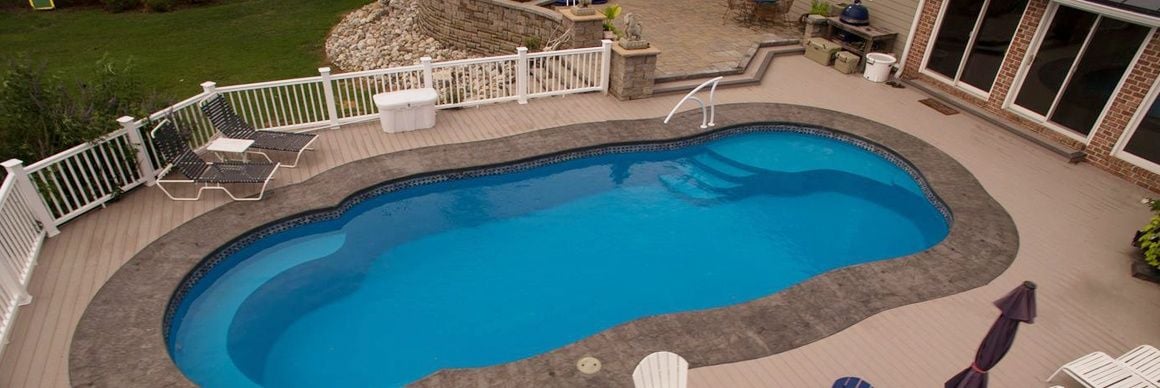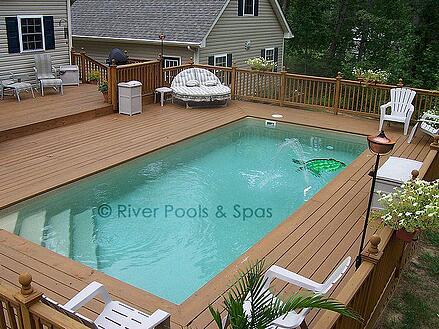
Above Ground Fiberglass Pools: Can and Should They Be Built?
Fiberglass Pool Information | Fiberglass vs Concrete vs Vinyl Liner | Patio and Coping | DIY Fiberglass Pools | Cost and Pricing
With the recent explosion of fiberglass pools in the swimming pool market throughout the world, I've been emailed a few times recently, and also asked by many of our local customers, whether or not such structures can be built above ground.
 Let me just start off saying a standard fiberglass pool is designed to be installed fully inground or partially above ground, but not for total on-ground installation without the support of backfill material.
Let me just start off saying a standard fiberglass pool is designed to be installed fully inground or partially above ground, but not for total on-ground installation without the support of backfill material.
When we speak in terms of a partial above-ground installation, this is normally where the shell is installed with up to 18 inches out of the ground with a framed deck installed at the level of the top of the pool.
A standard above-ground pool is actually not a fiberglass shell at all, but is composed of a steel wall panel and supports.
However, fiberglass pools can be customized by manufacturers who will "beef up" the structure by adding more fiberglass and supports that allow more of the shell to be installed above ground.
But the real question is: When is such an installation necessary?
4 Reasons People Want to Install Fiberglass Pools Above the Ground
- The homeowner thinks this will be a less expensive method of construction.
- The homeowner is concerned about potential flooding in their yard and wants the pool above this potential flood plain.
- The homeowner wants to have the level of the pool deck coming off a higher level of their house.
- The pool is built on a hillside and the homeowner wants to leave the downhill side exposed.
1. The homeowner thinks this will be a less expensive method of construction.
The reality is that just because a fiberglass pool is built partially out of the ground or fully out of the ground, very little, if any, money will be saved.
This is because the only savings would result from using less backfill material and the fact that concrete is not used for the patio.
These savings are usually offset, though, by the additional expense of framed decking which is usually close to double the cost of a concrete deck.
Many people think that because the pool is only partially in the ground and there is less excavating involved there will be a savings.
This is not the case because the time saved on excavating is actually marginal.
Therefore, if you're attempting to save money by installing your fiberglass pool above ground, I'm here to be the bearer of bad news and say that you're likely misinformed.
2. The homeowner is concerned about potential flooding in their yard (pool area) and wants the pool above this potential flood plain.
There is no doubt that elevating a fiberglass pool in low-lying areas can certainly help if there is ever a flood that inundates the swimming pool.
People often think that if a fiberglass pool is covered by flood water, it will pop out of the ground.
The reality is that this is almost never the case IF the pool has a cantilevered concrete patio, which serves as an anchor for the structure.
Rarely will a fiberglass pool float in such conditions. Rather, the pool water will become a mess, and days will be required to return it to normal conditions.
We have installed many pools in low-lying areas and have found that pools elevated in this manner perform very well over time.
3. The homeowner wants to have the level of the pool deck coming off a higher level of their house.
Usually the homeowner wants the pool to come off a higher deck on the house.
This can be one of the more tricky ways of installing a fiberglass pool.
If the pool needs to be elevated more than 18 inches, and is done without backfill, the structure must be:
- Custom built from the manufacturer as discussed earlier, ESPECIALLY if it's a straight wall pool
- Supported by an additional retaining wall around the shell that will allow the pool to have no more than 18 inches above grade
Custom-built from the manufacturer
This is especially true if it's a straight-wall pool.
Remember, any time a liquid-carrying vessel is curved, it's stronger.
I often use the analogy of a water tower. No one has ever seen a square water tower because they don't build them that way; they're all round.
This is also why your classic above-ground pool is round versus square. Round pools are naturally much stronger. This is also why oval above-ground pools need buttress supports on the sides to assist in the structural integrity of the pool.
Supported by an additional retaining wall around the shell
This retaining wall must allow the pool to have no more than 18 inches above grade.
For example, let's say the pool needs to be elevated 3 feet. You would simply build a retaining wall around the perimeter of the pool 18 inches tall and leave the remaining 18 inches of the shell above grade. This wall and exposed backfill material would then be covered by the framed deck.
This method performs well but can be a bit costly depending on the retaining wall material used.
4. The pool is built on a hillside and the homeowner wants to leave the downhill side exposed.
This is actually a great idea as long as no part of the pool is more than 18 inches above grade as discussed previously and some method of erosion control is used on the downhill side to prevent washing out of the backfill material and hillside.
Some materials that might work would be mulch, stone, plantings, etc.
Want to learn more about buying your perfect fiberglass pool?
I suggest that if you are considering building your fiberglass pool above the ground, you should at least consider all methods of building the pool flush with the ground.
In terms of creating your strongest fiberglass pool, nothing will beat a shell that's in the ground, with proper gravel backfill, and fortified with a cantilevered concrete bond beam.
Do you have any other questions about the process of buying the perfect fiberglass pool? Dive into our ebook, which includes all the details you’ll need to make the best decision for you and your family!
At River Pools we manufacture and install fiberglass pools in Virginia and southern Maryland. Our pools are also available in other states through our nationwide dealers.
Get in touch with us, and we’ll be happy to help you on your pool journey!
If you'd like to learn more about fiberglass swimming pools, you can download our free ebook below or check out our video library today.
Up Next:
Fiberglass FAQ: 14 Most Common Questions about Fiberglass Pools
What Is a Semi Inground Pool? A Review of Cost, Problems, and More
Concrete Pools vs. Fiberglass Pools: An Honest Comparison
Editor's note: This blog article was updated on August 21, 2020.






